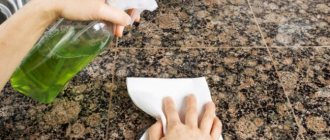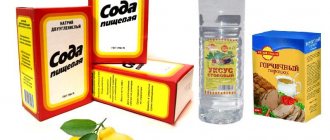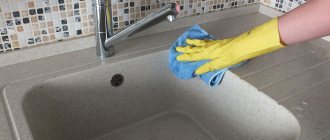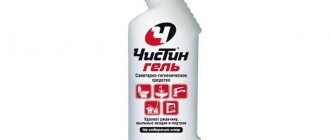May it serve for a long time!
Sinks made of artificial stone have recently become especially popular in the domestic market. This is due to the unique characteristics of the material from which they are made. Artificial stone is produced on the basis of natural mineral components with the addition of resin and coloring agents. It has a dense, homogeneous structure, has high strength and moisture resistance, is resistant to high temperatures, ultraviolet radiation, chemical reagents, and has good hygienic characteristics.
We talked about the pros and cons of artificial stone sinks, as well as the selection criteria, in a previous article. Now we will talk about how to extend the service life of the purchased product.
Advantages and disadvantages of stone sinks
There are practically no disadvantages to sinks made of artificial stone - apart from their enormous weight and high cost, we can safely say that these products have no disadvantages. There are, however, a couple more minor points, but, as a rule, they are not taken into account: firstly, you cannot place overheated dishes on an artificial stone sink, since a frying pan just removed from the stove can leave an irreparable mark on the material. Well, and secondly, such products are afraid of strong impacts - for example, if a sledgehammer falls from a height of half a meter onto the sink, then a crack will probably remain on it. Although in most cases this point primarily depends on the quality of the product - and hardly anyone will throw heavy objects into the sink on purpose.
Integrated sink made of artificial stone photo
Now, as for the advantages of sinks made of cast stone, there are quite a lot of them, but we will only focus on the main advantages. These include the following points:
- Very long service life. Almost all manufacturers of such sinks provide a guarantee of 10 years or more for their products - if we talk about the actual service life, then we can safely guarantee 50 years or more. Such a sink can be safely passed on to children and grandchildren. Naturally, all this depends primarily on the quality of workmanship, and it is for this reason that you need to purchase such products from trusted manufacturers.
- Hygienic or, as they also say, antiseptic - thanks to special additives, various pathogenic microbes are not diluted in such sinks. These sinks never have a putrid smell or similar unpleasant moments.
- A high-quality mortise sink made of artificial stone has a huge margin of safety, which exceeds the similar characteristics of products made of natural stone by two or even three times. It is even stronger than concrete. So a dropped pot or even a cast iron frying pan will not cause any harm to it.
- High degree of maintainability. Scratches and even chips can be removed very simply - the former are polished, and the latter are simply sealed using a special acrylic-based glue.
There are other advantages due to which modern sinks made of artificial stone have become widespread - for example, the absence of restrictions in production. The casting method can produce a sink of any shape and any color.
This is interesting: Pipeline laying methods and technologies
Chemical effect on stone.
Hard water with a high content of iron, chlorine, etc., also negatively affects the surface of the stone. It is clear that you should take care of the sink, stone sinks, you must use care products wisely, and do not use household chemicals in cleaning.
But not everyone is familiar with these conditions, and here’s the problem: repairs are needed.
Reasons for product failure
It is worth noting that any products made of artificial stone, including kitchen sinks, are highly durable and resistant to negative external factors. With proper care and proper use, a sink made of high-quality artificial stone will serve for many years.
However, even such a reliable household item can suffer. Let us highlight several main factors that negatively affect the appearance of a stone sink:
- dropping heavy utensils into the sink is highly likely to lead to defects,
- contact of natural stone surfaces with aggressive chemical composition (acid, alkali),
- ingress of boiling water, especially if the surface was previously very cool,
- using the surface as a cutting board (more likely to apply to countertops, but the sink can also suffer if you use it for other purposes).
Note that artificial stone is a material resistant to high temperatures. However, this does not mean that you should place hot pans and pots in a stone sink. To do this, use special stands with rubber feet or pads.
How to easily fix cracks, chips or scratches
Surface grinding
Scratches appear as a result of careless handling of sharp objects: a fork or knife. They do not interfere with operation, but spoil the appearance of the kitchen product.
The repair takes place in two stages:
- The defect is cleaned with sandpaper. It should only be medium grit.
- Polish with a felt circle. For this it is better to use a power tool.
Cautions for repairs:
- Do not put too much pressure on the tool while grinding the material;
- you must select one speed mode and not change it during operation;
- take only suitable tools;
- The polishing wheel must be new.
It is important to follow the above set of rules so as not to damage the sink, but to repair it.
Cracks and chips
Compared to a scratch, a crack is much more difficult to remove. This will require certain construction skills and a “repair kit”. It includes:
- putty;
- mastic;
- glue.
Repair work takes place in 3 stages:
- The surface is being prepared. It is dried, cleaned and degreased.
- The “repair kit” is applied.
- After the putty has dried, clean it up. In the same way as in removing scratches - sanding with a felt wheel.
If a small piece of the product breaks off, it must be found and glued. Procedure:
- The broken part is cleaned of dust, dirt, and then degreased.
- Select the required glue, it depends on the type of material.
- The piece is glued to its original place.
If the missing part cannot be found, acrylic that matches the color is glued. After it dries, sand it with sandpaper or a felt wheel.
Changed appearance
There is no need to rush into buying a new sink if the old one has changed its usual color. This happened due to improper care.
The problem is quite easy to fix. To do this you will need a grinder and a suitable circle. The product is carefully polished, after which its appearance becomes attractive again.
Customer Reviews
Ivan, St. Petersburg : “I bought a sink made of artificial stone for my kitchen. But, after dinner, he threw dirty dishes at her. It turned out that the fork scratched the bottom. Fixed this problem quite easily. I needed a grinder and a circle. I quickly sanded out the flaw and the sink looks like new.”
Irina, Krasnodar : “My husband gave me a new stone washbasin. Inadvertently, I broke off a small piece on the corner. It's good that he didn't get lost. My husband bought a special glue for acrylic, degreased it and glued it in its original place. I was upset, the glue stain was noticeable. But after sanding everything went away. Now I will be careful in using it. Very pleased with the purchase."
Artificial stone sink repair
Even with proper care, the sink can be damaged - for example, as a result of a heavy piece of dishes falling on it.
One of the advantages of plumbing fixtures made of artificial stone is that they can be repaired in case of any damage. During the repair, defective areas are filled with a composite composition, and small and large cracks, chips, and any irregularities are eliminated. The technology may vary depending on the type and size of the damage.
If, as a result of improper use or poor care, the sink has lost its attractive appearance or scratches have appeared - do not rush to get upset, as it can be sanded and restored to its original beauty. Artificial stone has a uniformly colored internal texture, so even numerous grindings are not harmful to it.
Stages of work when eliminating surface defects:
- Milling (cutting out the damaged area, forming a hole of the correct shape).
- Preparing the surface for gluing. For this, special cleaners, liquids, pastes are used (they remove many types of contaminants: dust, wax, oil, grease, soot, tar stains, rubber, etc.).
- Manufacturing (from a similar material) a part of the required shape and size to cover the damage site. Particular attention should be paid to the choice of color shade so that the restored area does not stand out against the general background.
- Gluing the finished fragment (the glue is selected taking into account the characteristics of the stone).
- Sanding to obtain a smooth, even surface.
The restoration process is not particularly complicated, and if all the necessary materials are available, it can be carried out on your own at home. However, such work requires experience, so it is best to entrust the removal of serious defects to professionals. It is best to seek help from specialists from manufacturing companies or their representatives on the domestic market (when using imported products). If there are no manufacturer representatives in your city, you can order a sink repair service from local suppliers and installers of artificial stone sinks and countertops.
There is no need to transport damaged plumbing to production; all work can be completed on site.
If a small fragment breaks off from the sink, you can glue it yourself using acrylic glue. Carefully sand the gluing area with fine sandpaper.
See also:
How to choose the color of the countertop for the kitchen set?
Moydodyr in the bathroom: overhead and built-in sinks
How to wash a mirror without streaks?
The smell in the house
How is a crack in a countertop or stone sink repaired?
First of all, it is necessary to find out the cause of the crack. Eliminating incorrect installation or sagging, the craftsman will reinforce the stone on the back side of the damage, if necessary, without removing the sink. Cleans the crack site with chemicals, mechanically cleans, degreases and dries the marble surface for further work.
For repairs, epoxy marble adhesive is used; unlike polyester, it is not afraid of moisture, is easier to tint and can withstand loads. A pigment of the required color is added to the stone adhesive so that the repair area does not differ.
Further, depending on the type of glue, the master waits for complete drying, an hour is enough, but if the glue is daily drying, he arrives for further repairs a day later or by agreement.
This is interesting: Rough ceiling on wooden beams, how to properly line it with boards in a private house, rough finishing of the ceiling in a wooden house, lining with plywood on beams, how to do it
Damage options for composite sinks
- Scratches are the result of careless washing of cutting objects, cutting food on the sink, or cleaning the product using abrasives and metal sponges.
- Cracks - occur as a result of strong impacts, sudden temperature changes, and also due to violations of the product’s production technology.
- Blistering of the top layer and white spots are formed if you place hot pots or pans fresh from the stove on a stone surface, as well as when using strong chemicals.
- Chips – appear as a result of falling a heavy object or metal kitchen utensil.
The method of restoring an artificial stone sink is selected depending on the type and extent of damage.
Punching a hole in the sink
Some artificial stone sinks have cast plugs that are knocked out during installation. They are usually color coded on the front. First of all, the sink is installed in place in the countertop, but is not fixed.
Then you need to choose the right tool and beat off the plugs with a strong blow with a hammer. A punch with a diameter of 8 mm is suitable for this role, but not a screwdriver. You only need to knock out the cork from the top: that is, from the front side. Use a rasp to smooth out the uneven edges of the hole.
Types of damage and stages of repair work
We have a little insight into the causes of the damage. Now let's find out the dangers of a careless attitude towards plumbing fixtures made of artificial stone. Some of the common damages are the following defects:
- formation of chips and scratches,
- appearance of cracks,
- chemical burns to the surface.
Generally speaking, during repair work, surface defects (chips, cracks, scratches) are filled with a special composite composition, followed by leveling and sanding. Technological processes may vary depending on the area of damage and its type.
Let's look at the basic stages of repairing serious defects that require making a new part and gluing it in place of the damaged area.
The main stages of repair work.
- Milling is cutting out a damaged surface area and preparing a hole of the correct shape.
- Treatment of the surface intended for gluing with special pastes, liquids, and cleaners. These products can dissolve various contaminants - grease, dirt, wax, soot, rubber.
- Manufacturing a part taking into account the shape and size of the damage site. It is made from a similar material. It is important to pay attention to the color of the patch so that after the restoration is completed, this area will not be noticeable against the general background.
- Gluing the fragment. It is important to choose the glue, taking into account the characteristics of the artificial stone.
- Grinding. The main goal of this process is to obtain a flat and smooth surface, without flaws.
How to fix a sink with your own hands? Obviously, the restoration process is not particularly complex. If you have all the necessary materials and tools at hand, then it is quite possible to eliminate a defect from the surface of a sink or sink yourself.
Repairing chips
The method is suitable for large and deep chips. Stages of work:
- The product is inspected, the boundaries of the damaged area are marked, followed by cutting it out.
- Preparing a piece of stone similar to the carved part.
- Degreasing, covering the working area with glue.
- Install and hold the piece until the glue completely hardens.
- Grinding and polishing of stone surfaces.
If the chips are small, then the surface of the damaged area is cleaned and degreased. Then the problem area is filled with epoxy resin (glue), to which pigment and mineral chips are added. After hardening, the surface is cleaned with sandpaper and polished with felt.
How to repair a structure yourself
Chip on the sink
Repair of an artificial stone sink depends on the nature of the damage. Common defects that appear due to negligence:
- scratches, cracks and chips;
- chemical damage.
Such defects can be easily repaired using a “repair kit”, which is sold at any hardware store.
It is more difficult to repair a sink made of artificial stone with your own hands when part of the fragment is chipped and you need to replace the material. To do this, the necessary stone is made and glued to the chip site.
Sequence of actions for self-repair:
- Milling the required part of the sink. To do this, cut out and clean the damaged area. A recess in the sink is prepared to replace the damaged part.
- The damaged part is treated with specialized chemicals: paste, liquid or cleaner. This will help get rid of dirt and grease.
- The required part is made, taking into account its size and shape. For this, the same artificial material is selected. It is important to choose the right color of the stone so that after the repair the replacement is not visible.
- Glue the missing fragment of the sink. To do this, buy specialized glue for artificial material, taking into account its characteristics.
- Grinding the sink is the final stage in the repair. Will make the surface of the sink smooth, without flaws.
Repairs will not take much time, but will save the family budget.
Homemade adhesives
Sink structure: 1 - wall mounting; 2 - bracket, 3 - drain, 4 - wide nut, 5 - lock nut, 6 - glass, 7 - cement, 8 - sewer.
It is possible to make glue with your own hands. For example, to glue a ceramic or earthenware toilet, you can prepare an adhesive based on casein.
The first recipe. 10 parts of casein and 1 part of borax are mixed in 2 parts of water, then another 2 parts of water are added. To make a waterproof seam, you need to add a few drops of a solution of aluminum alum or formaldehyde to the finished solution. This glue hardens in 2-3 hours - during this time it should be used for its intended purpose.
In order to glue large porcelain or earthenware objects (a toilet or a cistern, for example), you can prepare the following adhesive composition:
- 1 part crushed glass;
- 2 parts of sifted river sand;
- 6 parts of liquid glass or silicate glue.
This glue is quite strong, but it is very difficult to make the seam with it unnoticeable.
Second recipe:
- 1 part quicklime;
- 10 parts chalk;
- 2.5 parts liquid glass.
This composition should be prepared immediately before use, when the surfaces are completely prepared for gluing, as it hardens quickly.
Recipe three. For future production, a different glue composition is suitable. It requires 1 part turpentine (by weight) and 2 parts light shellac. Melt turpentine and shellac over low heat, mix well and cool. Next, the resulting mass can be divided into small tiles and stored.
This glue is stored for quite a long time; before use, it should be warmed up and applied in a thin layer to the surfaces to be glued, which then need to be strongly compressed. Excess glue that protrudes is immediately removed.
Fourth recipe. A porcelain toilet or other items made of this material can be glued together with a gypsum-based compound. To prepare such glue you will also need ordinary alum. This glue is prepared as follows: burnt gypsum is soaked in a saturated alum solution for 24 hours, then it is dried, calcined and crushed, then diluted with water to the consistency of sour cream.
Bonding a Marble Sink
Pipe gluing.
In order to manage to break a marble sink or toilet into several pieces, these objects must at least be dropped onto a hard surface. But more often it happens that a hard, heavy object falls on them, in this case the marble will not split into pieces, but there will definitely be small chips. Sometimes this results in cracks.
To restore such objects, a paste of ground alabaster in glue water is used, which is suitable for white marble. And if necessary, add crushed slate, ocher or other fillers to give the mixture the required shade. After such putty hardens on seams or cracks, it should be polished.
Recipe five. Mix crushed gypsum in 4 parts with 1 part of powdered gum arabic. A strong solution of borax in cold water is added to the resulting mixture until it forms a batter. The item glued in this way is left for 5-7 days in a cool place.
If you need to make the seam almost invisible, then a cracked marble toilet or sink can be glued together using a mixture based on the same marble, but ground into powder.
Recipe six. Mix the powdered marble with rubber and wax in the following proportion: 2 parts marble powder, 2 parts wax and 1 part natural rubber. The mixture is heated in a water bath, then it is applied to the surfaces to be glued, well prepared, compressed and excess glue is removed.
Another recipe for gluing earthenware and glass looks like this: dissolve 100 g of slaked lime and 100 g of sugar in 1 liter of water. All this is cooked over low heat for 3 hours without boiling. Then the mixture settles and the water is drained. Add 0.5 kg of crushed tile adhesive, stir the mass and leave for half a day. Next, excess water is drained from the swollen glue, and it is placed on low heat to completely dissolve. This glue is used in a cooled state.
This glue is still inferior to synthetic glue in such parameters as water resistance and susceptibility to microorganisms. But in the absence of a synthetic adhesive composition, this one will do until it becomes possible to use a more durable one.
Of course, the provided list of synthetic ready-made and self-made adhesives is not exhaustive. In our time of constant development and innovation, other brands can be found in specialized stores.
How to drill a hole
Very often, ceramic sinks are made without a special hole for the tap. This happens because most modern faucets are installed on the wall near the sink.
But there are situations when the faucet needs to be built into the side of a ceramic sink, and then it is advisable to watch a video on how to drill a sink.
But when it is not possible to see the whole process on the screen, we suggest that you read the written version of how to drill a hole in a ceramic sink yourself.
The first step is to decide how to drill a ceramic sink; the answer is simple - a drill. This is done not with an ordinary drill, but with a special attachment for ceramic products.
A crown attachment with a diamond core is suitable for this purpose, which will allow you to drill without adding water and cooling the drill itself.
Sales consultants in the store will help you choose the right crown. If everything is done correctly, the problem will be solved. than to drill or seal a hole.
Nowadays it is important not to radically change everything during renovation, but to breathe new life into old objects that have an attractive appearance. Therefore, the question may arise of how to seal a ceramic sink for restoration.
There are such adhesive materials for ceramics:
- waterproof glue;
- silicone sealant;
- cold welding.
Use a hair dryer first to get rid of unnecessary moisture. Now you can seal the crack (for example, with waterproof glue) and leave it to dry for at least four hours.
Then you should apply epoxy putty at the joints and sand the repair area with fine-grained sandpaper.
Sink restoration, masking cracks
Ceramics tend to crack, impacts are especially dangerous for it, or this process occurs over time.
That’s when the question arises: how to repair a crack in a ceramic sink and give it a neat look. Specially developed sealants that are waterproof are often used for such work. You should purchase a good quality composition suitable for a ceramic sink in a store and simply cover the cracks with it.
Naturally, you should first clean the repair area from rust, mold and grease and dry it. Now you know exactly how to repair a crack and can safely go to the store for materials.
Types of fastenings and connection methods
Overhead method of installing a sink
Installation of a kitchen sink made of artificial stone is carried out in various ways. It is possible to install the sink yourself, without outside help.
There are four types of fastenings:
- invoice;
- mortise;
- integrated;
- under-desk.
Each of them has its own installation features.
Invoice
One of the simplest installation methods is to “lay” the sink on top of the cabinet, after first removing the countertop.
The required size is ordered in a specialized store. If it is not there, cut off the remains yourself. To do this, the material is placed on the tabletop, the excess is highlighted with a marker, and cut off.
But it’s better to order a sink and a cabinet ready for it - installation is easy and quick. There are two ways:
- adhesive;
- using brackets.
In the first case, the sink is placed on a cabinet, having previously treated the ends with hermetic silicone.
In the second case, you need to tighten the screws on the inside of the cabinet and install the brackets. The sink is positioned and the screws are tightened tightly.
Mortise
Products are cut out according to a prepared template. Inside the tabletop, moving 2-3 centimeters from the edge, draw a line. Holes are made in it, the outline is cut out, and the sawdust is cleaned. The fasteners are placed on the sink and installed in a slot lubricated with silicone.
Integrated
The sink is mounted on the same level as the countertop; they are made from the same material. In most cases, ready-made samples are ordered from factories: the sink is installed immediately with the countertop.
Repairing a chipped ceramic sink
It is possible to repair a chip on the sink yourself using specialized sealants or putties. For reliable results, you should perform the following actions:
- clean the damaged surface;
- dry the repair area;
- dilute the ceramic putty according to the directions on the package;
- apply fastening material (putty) to the chip site so that it protrudes beyond the edges (the putty will dry out);
- let the putty dry;
- sand with fine-grained sandpaper until smooth;
- Paint the seam with the appropriate color, and remove excess paint from the surface with acetone.











